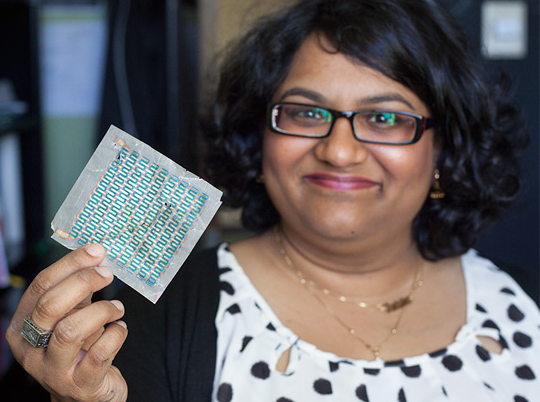Save power, make power: UW chemist confronts ambitious agenda with a brash laugh

Trisha Andrew, a UW assistant professor of chemistry, holds a solar cell that her research group printed on paper last year. She’s currently working to invent ways to convert light into electricity, using dyes rather than silicon devices.
Photo: Matt Wisniewski/Wisconsin Energy Institute
Trisha Andrew wants to save billions of watt hours by revolutionizing, well, just about every electronic device in existence. She suggests this be done by controlling the spin on electrons, and then shutting down devices if the proper spin is absent.
That’s a lofty goal for any assistant professor — even one like Andrew, whose string of awards began long before she started working at the University of Wisconsin–Madison Department of Chemistry in 2010. In 2013, she received the 3M Non-Tenured Faculty Award, and this October, she was named a Packard Fellow for Science and Engineering. The $875,000 award will help support her research for five years.
So Andrew is also working on a new method to make flexible solar cells that are cheap enough to be disposable. Just a few weeks ago, she says, Yuelin Peng, a graduate student in electrical and computer engineering, showed a prototype that was printed on paper and is able to charge a smartphone under fluorescent light. “The physics of PVs (photovoltaics) are incredibly well known,” she says, “and as a young professor starting up, it seems logical to start with something you know. My students can learn device physics and fabrication, but I also wanted to do something cool and useful.”
“If you have a really good idea in America, and have an entrepreneurial spirit and can make it work, you can benefit civilization. That’s important to me … ”
Trisha Andrew
Why print the first PVs on paper? “The paper part was us being cute. What is the last thing you want a PV on? Paper!” says Andrew, who laughs more often than the stereotypical hard-science professor. Although paper made a point about a low-price PV, she admits that the current versions are formed on plastic.
The commercial possibilities of low-cost PV are obvious and being pursued, she says. “If you have a really good idea in America, and have an entrepreneurial spirit and can make it work, you can benefit civilization. That’s important to me, in addition to the intellectual interest.”
In other words, before turning the electronic industry topsy-turvy, she’ll expend a bit of effort revolutionizing the energy industry.
Andrew, the only child of Indian-born parents, spent her first 10 years in the Middle East. “My father in the late 1970s went to Saudi Arabia to work in the oil industry. He was ambitious, and figured out that the company would pay him to get an MBA, so he did.” His success at writing computer code led to job offers, so the family “hopped around to 17 oil-producing countries before I was 10,” she says. “My parents never say no to an adventure, never told me I had boundaries, rarely reprimanded me (and) were super supportive.”
After getting bachelor’s degrees in chemistry and electrical engineering at the University of Washington, Andrew did graduate and postdoctoral work at MIT. There, she focused on optoelectronics — materials that make light when they receive an electric current, or vice versa — and on organic electronics, devices based on carbon rather than the standard silicon.
Her mentor at MIT, Vladimir Bulović, a professor of electrical engineering and computer science, told her he looked for cool people as students, and she has followed suit. “I want them to be self-motivated, passionate, to work well with my existing group. I’m a hands-off mentor. The students I tend to attract have a self-burning fire that I stoke once in a while.”
Photovoltaics depend on materials that are excellent at absorbing light, she says and, “there is no material that absorbs light as well as dye, not even the silicon used in commercial solar cells. People don’t think about using car paint in their electronic devices, but that’s what we do.”
“We’ve been talking about starting a consortium lab, linking people across the country … so we can move technology forward in a collaborative university environment.”
Trisha Andrew
The latest is Ferrari red, which contains the pigment used to make the hallmark color of a racing legend.
Organic electronics, built on carbon structures, offer practical advantages, she says. “You can make a film easily, and do it at room temperature; you don’t need a plant that heats to 900 degrees C. So the capital cost is low, and you can think outside the box; make a PV on something as ridiculous as paper.”
Another area of interest is reducing wasted electricity in electronics. The problem is a quantum-mechanical phenomenon called tunneling currents, she says. “It’s not just the display, but as long as it’s plugged in, even if the power switch is off, you have a completed circuit, and it draws leakage current. This happens in every transistor in every device, and it drains about 5 percent of overall, global electricity consumption at any one time.”
Electrons have a characteristic called spin, and “if you could change the structure of the electronic circuit so it only passes electricity of one spin or the other, then you could control this current and prevent the leak,” Andrew explains.
That would, of course, require reconfiguring every bit of electronics.
Beyond overturning industrial behemoths, Andrew also ponders social engineering that would better promote innovation. “We’ve been talking about starting a consortium lab, linking people across the country, bringing together designers, artists, engineers, economists and social scientists, so we can move technology forward in a collaborative university environment.”
Young, brash and brainy, Andrew is clearly not intimidated by big ideas and big challenges.



